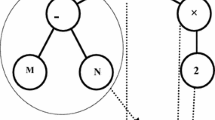Abstract
The hybrid genetic algorithm is utilized to facilitate model parameter estimation. The tri-dimensional compression tests of soil are performed to supply experimental data for identifying nonlinear constitutive model of soil. In order to save computing time during parameter inversion, a new procedure to compute the calculated strains is presented by multi-linear simplification approach instead of finite element method (FEM). The real-coded hybrid genetic algorithm is developed by combining normal genetic algorithm with gradient-based optimization algorithm. The numerical and experimental results for conditioned soil are compared. The forecast strains based on identified nonlinear constitutive model of soil agree well with observed ones. The effectiveness and accuracy of proposed parameter estimation approach are validated.
Similar content being viewed by others
References
CHAPARRO B M, THUILLIER S, MENEZES L F, MANACH P Y. Material parameters identification: Gradient-based, genetic and hybrid optimization algorithms [J]. Computational Materials Science, 2008, 44(2): 339–346.
RECHEA C, LEVASSEUR S, FINNO R. Inverse analysis techniques for parameter identification in simulation of excavation support systems [J]. Computers and Geotechnics, 2008, 35(3): 331–345.
LIU G R, LEE J H, PATERA A T. Inverse identification of thermal parameters using reduced-basis method [J]. Comput Methods Appl Mech Engrg, 2005, 194(27/28/29): 3090–3107.
HE R S, HWANG S F. Damage detection by an adaptive real-parameter simulated annealing genetic algorithm [J]. Computers and Structures, 2006, 84(31/32): 2231–2243.
NYARKO E K, SCITOVSKI R. Solving the parameter identification problem of mathematical models using genetic algorithms [J]. Applied Mathematics and Computation, 2004, 153(3): 651–658.
WEI D C. An improved real-coded genetic algorithm for parameters estimation of nonlinear systems [J]. Mechanical Systems and Signal Processing, 2006, 20(1): 236–246.
KHALIK M A, SHERIF M, SARAYA S. Parameter identification problem: Real-coded GA approach [J]. Applied Mathematics and Computation, 2007, 187(2): 1495–1501.
GALDI V, IPPOLITO L, PICCOLO A, VACCARO A. Parameter identification of power transformers thermal model via genetic algorithms [J]. Electric Power Systems Research, 2001, 60(2): 107–113.
TUTKUN N. Parameter estimation in mathematical models using the real coded genetic algorithms [J]. Expert Systems with Applications, 2009, 36(2): 3342–3345.
LI S J, LIU Y X. Identification of vibration loads on hydro generator by using hybrid genetic algorithm [J]. Acta Mechanica Sinica, 2006, 22(6): 603–610.
PERRY M J, KOH C G, CHOO Y S. Modified genetic algorithm strategy for structural identification [J]. Computers and Structures, 2006, 84(8/9): 529–540.
HWANG S F, WU J C, HE R S. Identification of effective elastic constants of composite plates based on a hybrid genetic algorithm [J]. Composite Structures, 2009, 90(2): 217–224.
HWANG S F, HE R S. Improving real-parameter genetic algorithm with simulated annealing for engineering problems [J]. Advances in Engineering Software, 2006, 37(6): 406–418.
YEH W W. Review of parameter identification procedures in groundwater hydrology: The inverse problem [J]. Water Resour Res, 1986, 22(2): 95–108.
FRANULOVIC M, BASAN R, PREBI I. Genetic algorithm in material model parameters identification for low-cycle fatigue [J]. Computational Materials Science, 2009, 45(2): 505–510.
CHANG W D. Nonlinear system identification and control using a real-coded genetic algorithm [J]. Applied Mathematical Modelling, 2007, 31(3): 541–550.
CHANG W D. Coefficient estimation of IIR filter by a multiple crossover genetic algorithm [J]. Computers and Mathematics with Applications, 2006, 51(9/10): 1437–1444.
XU T, ZUO W J, XU T S. An adaptive reanalysis method for genetic algorithm with application to fast truss optimization [J]. Acta Mechanica Sinica, 2010, 26(2): 225–234.
REN Z W, SAN Y, CHEN J F. Hybrid simplex-improved genetic algorithm for global numerical optimization [J]. Acta Mechanica Sinica, 2007, 23(1): 91–95.
LI S J, LIU Y X. Inverse determination of model parameters of nonlinear heat conduction problem using hybrid genetic algorithm [J]. Nonlinear Dynamics and Systems Theory, 2007, 7(1): 23–34.
KONDNER R L. Hyperbolic stress-strain response: cohesive soil [J]. Journal of the Soil Mechanics and Foundations Division, 1963, 89(SM1): 115–143.
DUNCAN J M, CHANG C. Nonlinear analysis of stress and strain in soils [J]. Journal of the Soil Mechanics and Foundations Division, 1970, 96(SM5): 1629–1653.
SHANGGUAN Z C, LI S J, LUAN M T. Estimating model parameters of conditioned soils by using artificial network [J]. Journal of Software, 2010, 5(3): 296–302.
YU H, LI S J, DUAN H X, LIU Y X. A procedure of parameter inversion for a nonlinear constitutive model of soils with shield tunneling [J]. Computers and Mathematics with Application, 2011, 61(8): 2005–2009.
Author information
Authors and Affiliations
Corresponding author
Additional information
Foundation item: Project(2007CB714006) supported by the National Basic Research Program of China; Project(90815023) supported by the National Natural Science Foundation of China
Rights and permissions
About this article
Cite this article
Li, Sj., Shao, Lt., Wang, Jz. et al. Inverse procedure for determining model parameter of soils using real-coded genetic algorithm. J. Cent. South Univ. Technol. 19, 1764–1770 (2012). https://doi.org/10.1007/s11771-012-1203-2
Received:
Accepted:
Published:
Issue Date:
DOI: https://doi.org/10.1007/s11771-012-1203-2




